首先在Mysql中新建一个表bus_student
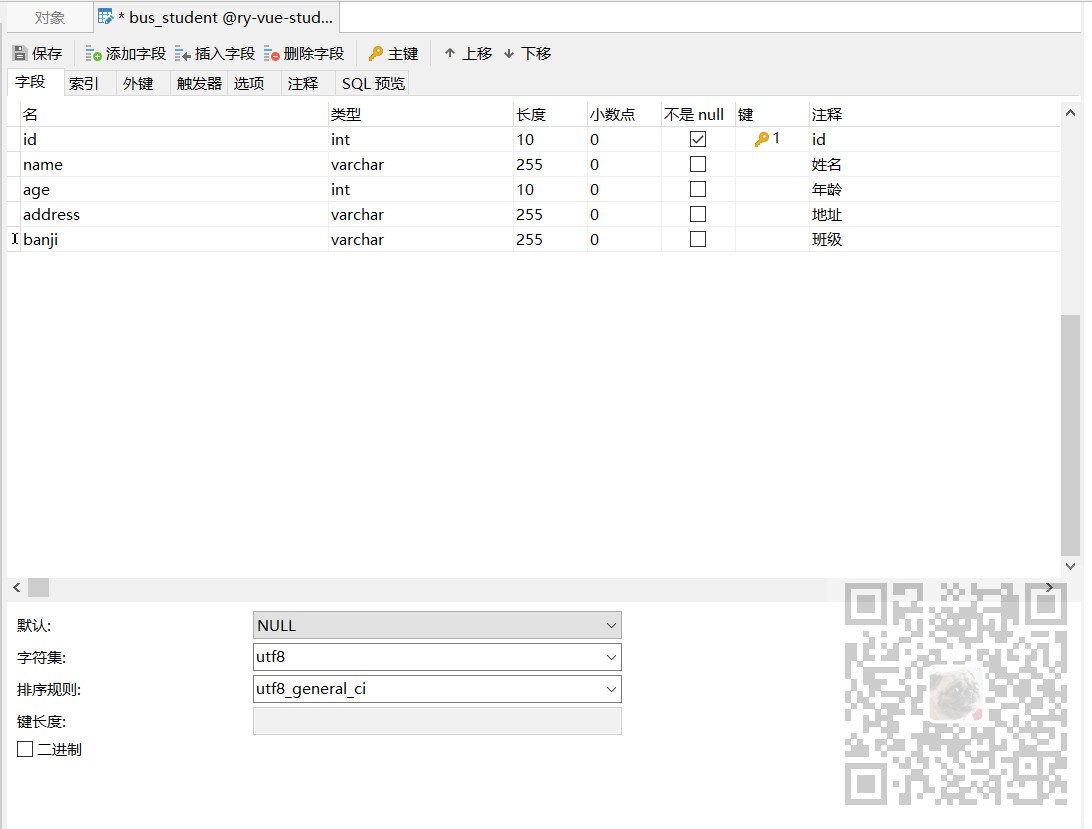
然后基于此表使用代码生成,前端Vue与后台各层代码生成并添加菜单。
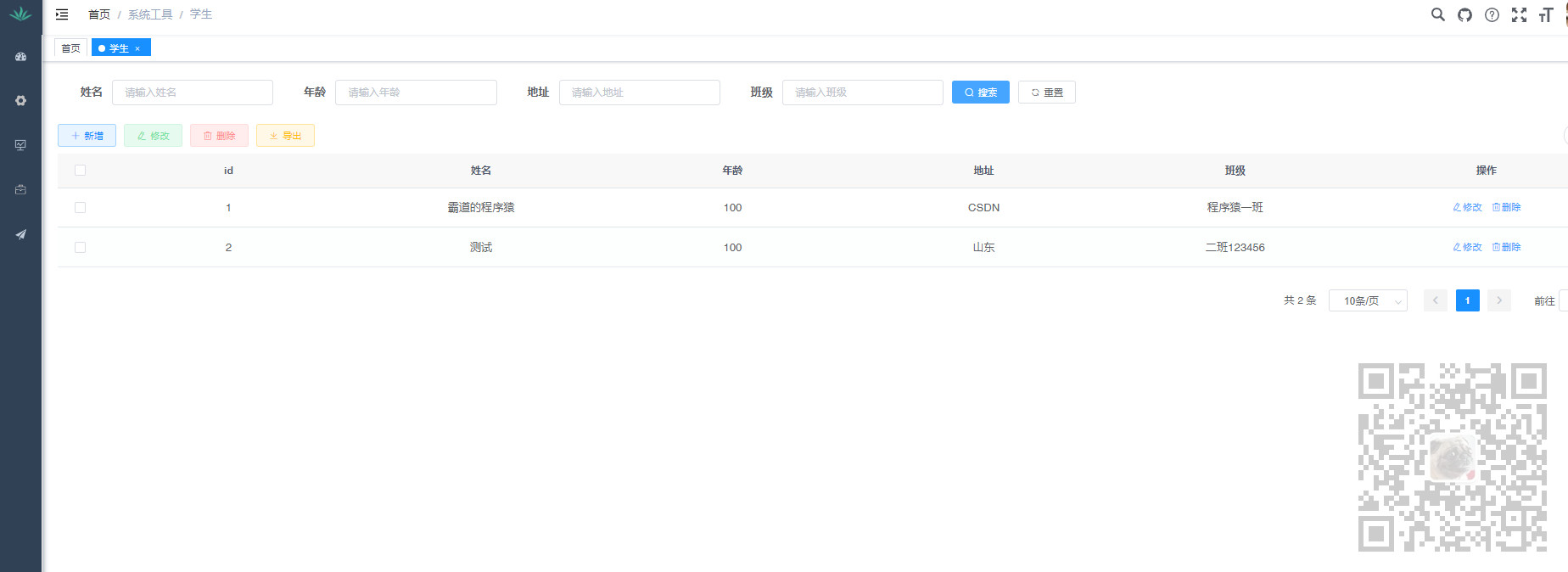
然后来到后台代码中,在后台框架中已经添加了操作redis的相关依赖和工具类。
但是这里还需要添加aspect依赖
<!-- https://mvnrepository.com/artifact/org.springframework/spring-aspects --><dependency>
<groupId>org.springframework</groupId>
<artifactId>spring-aspects</artifactId>
<version>4.3.14.RELEASE</version>
</dependency>然后在存放配置类的地方新建新增redis缓存的注解
package com.ruoyi.system.redisAop;
import java.lang.annotation.ElementType;
import java.lang.annotation.Retention;
import java.lang.annotation.RetentionPolicy;
import java.lang.annotation.Target;/*
* @Author
* @Description 新增redis缓存
**/@Retention(RetentionPolicy.RUNTIME)
@Target(ElementType.METHOD)public @interface AopCacheEnable {//redis缓存key String[] key();//redis缓存存活时间默认值(可自定义)long expireTime() default 3600;
}以及删除redis缓存的注解
package com.ruoyi.system.redisAop;
import java.lang.annotation.ElementType;
import java.lang.annotation.Retention;
import java.lang.annotation.RetentionPolicy;
import java.lang.annotation.Target;/*
* @Description 删除redis缓存注解
**/@Target(ElementType.METHOD)
@Retention(RetentionPolicy.RUNTIME)public @interface AopCacheEvict {//redis中的key值 String[] key();
}然后再新建一个自定义缓存切面具体实现类CacheEnableAspect
存放位置
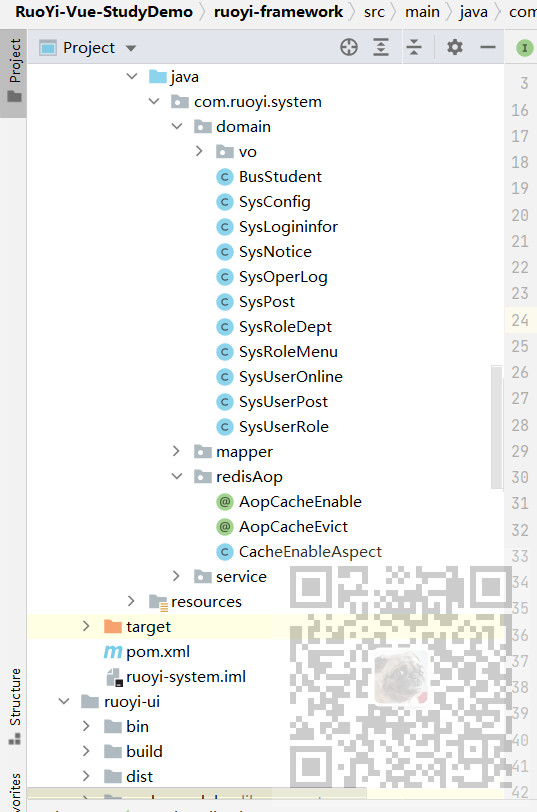
package com.ruoyi.system.redisAop;
import com.ruoyi.system.domain.BusStudent;
import org.aspectj.lang.ProceedingJoinPoint;
import org.aspectj.lang.Signature;
import org.aspectj.lang.annotation.Around;
import org.aspectj.lang.annotation.Aspect;
import org.aspectj.lang.annotation.Pointcut;
import org.aspectj.lang.reflect.MethodSignature;
import org.springframework.beans.factory.annotation.Autowired;
import org.springframework.data.redis.core.RedisTemplate;
import org.springframework.stereotype.Component;
import java.lang.reflect.Method;
import java.util.ArrayList;
import java.util.List;
import java.util.concurrent.TimeUnit;/*
* @Description 自定义缓存切面具体实现类
**/@Aspect
@Componentpublic class CacheEnableAspect {
@Autowiredpublic RedisTemplate redisCache;/**
* Mapper层切点 使用到了我们定义的 AopCacheEnable 作为切点表达式。 */@Pointcut("@annotation(com.ruoyi.system.redisAop.AopCacheEnable)")public void queryCache() {
}/**
* Mapper层切点 使用到了我们定义的 AopCacheEvict 作为切点表达式。 */@Pointcut("@annotation(com.ruoyi.system.redisAop.AopCacheEvict)")public void ClearCache() {
}
@Around("queryCache()")public Object Interceptor(ProceedingJoinPoint pjp) {
Object result = null;//注解中是否有#标识boolean spelFlg = false;//判断是否需要走数据库查询boolean selectDb = false;//redis中缓存的keyString redisKey = "";//获取当前被切注解的方法名Method method = getMethod(pjp);//获取当前被切方法的注解AopCacheEnable aopCacheEnable = method.getAnnotation(AopCacheEnable.class);//获取方法参数值Object[] arguments = pjp.getArgs();//从注解中获取字符串String[] spels = aopCacheEnable.key();for (String spe1l : spels) {if (spe1l.contains("#")) {//注解中包含#标识,则需要拼接spel字符串,返回redis的存储redisKeyredisKey = spe1l.substring(1) + arguments[0].toString();
} else {//没有参数或者参数是List的方法,在缓存中的keyredisKey = spe1l;
}//取出缓存中的数据result = redisCache.opsForValue().get(redisKey);//缓存是空的,则需要重新查询数据库if (result == null || selectDb) {try {
result = pjp.proceed();//从数据库查询到的结果不是空的if (result != null && result instanceof ArrayList) {//将redis中缓存的结果转换成对象listList<BusStudent> students = (List<BusStudent>) result;//判断方法里面的参数是不是BusStudentif (arguments[0] instanceof BusStudent) {//将rediskey-students 存入到redisredisCache.opsForValue().set(redisKey, students, aopCacheEnable.expireTime(), TimeUnit.SECONDS);
}
}
} catch (Throwable e) {
e.printStackTrace();
}
}
}return result;
}/*** 定义清除缓存逻辑,先操作数据库,后清除缓存*/@Around(value = "ClearCache()")public Object evict(ProceedingJoinPoint pjp) throws Throwable {//redis中缓存的keyMethod method = getMethod(pjp);// 获取方法的注解AopCacheEvict cacheEvict = method.getAnnotation(AopCacheEvict.class);//先操作dbObject result = pjp.proceed();// 获取注解的key值String[] fieldKeys = cacheEvict.key();for (String spe1l : fieldKeys) {//根据key从缓存中删除 redisCache.delete(spe1l);
}return result;
}/**
* 获取被拦截方法对象 */public Method getMethod(ProceedingJoinPoint pjp) {
Signature signature = pjp.getSignature();
MethodSignature methodSignature = (MethodSignature) signature;
Method targetMethod = methodSignature.getMethod();return targetMethod;
}
}注意这里的queryCache和ClearCache,里面切点表达式
分别对应上面自定义的两个AopCacheEnable和AopCacheEvict。
然后在环绕通知的queryCache方法执行前后时
获取被切方法的参数,参数中的key,然后根据key去redis中去查询,
如果查不到,就把方法的返回结果转换成对象List,并存入到redis中,
如果能查到,则将结果返回。
然后找到这个表的查询方法,mapper层,比如要将查询的返回结果存储进redis
@AopCacheEnable(key = "BusStudent",expireTime = 40)public List<BusStudent> selectBusStudentList(BusStudent busStudent);
然后在这个表的新增、编辑、删除的mapper方法上添加
/**
* 新增学生
*
* @param busStudent 学生
* @return 结果 */@AopCacheEvict(key = "BusStudent")public int insertBusStudent(BusStudent busStudent);/**
* 修改学生
*
* @param busStudent 学生
* @return 结果 */@AopCacheEvict(key = "BusStudent")public int updateBusStudent(BusStudent busStudent);/**
* 删除学生
*
* @param id 学生ID
* @return 结果 */@AopCacheEvict(key = "BusStudent")public int deleteBusStudentById(Integer id);注意这里的注解上的key要和上面的查询的注解的key一致。
然后启动项目,如果启动时提示:
Consider marking one of the beans as @Primary, updating
the consumer to acce

因为sringboot通过@Autowired注入接口的实现类时发现有多个,也就是有多个类继承了这个接口,spring容器不知道使用哪一个。
找到redis的配置类,在RedisTemplate上添加@Primary注解
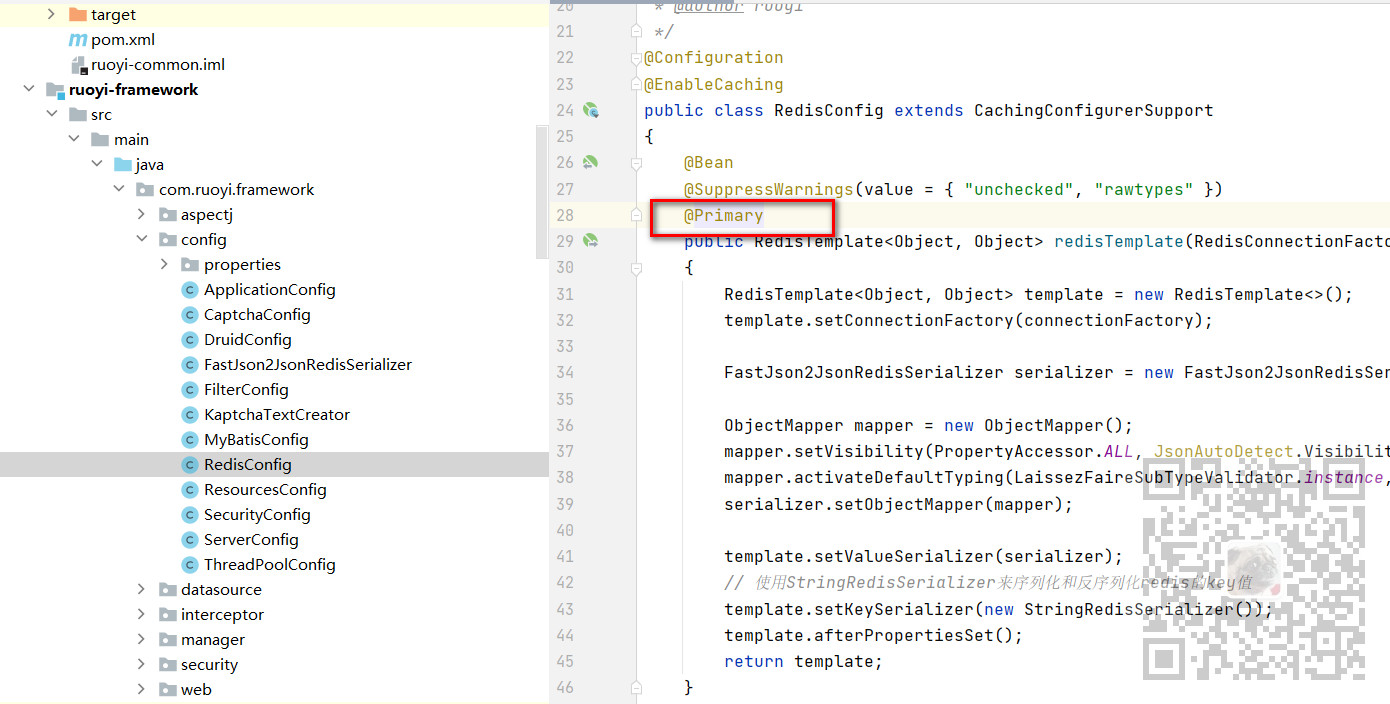
验证注解的使用
debug启动项目,在CacheEnableAspect中查询注解中打断点,然后调用查询方法,
就可以看到能进断点,然后就可以根据自己想要的逻辑和效果进行修改注解。
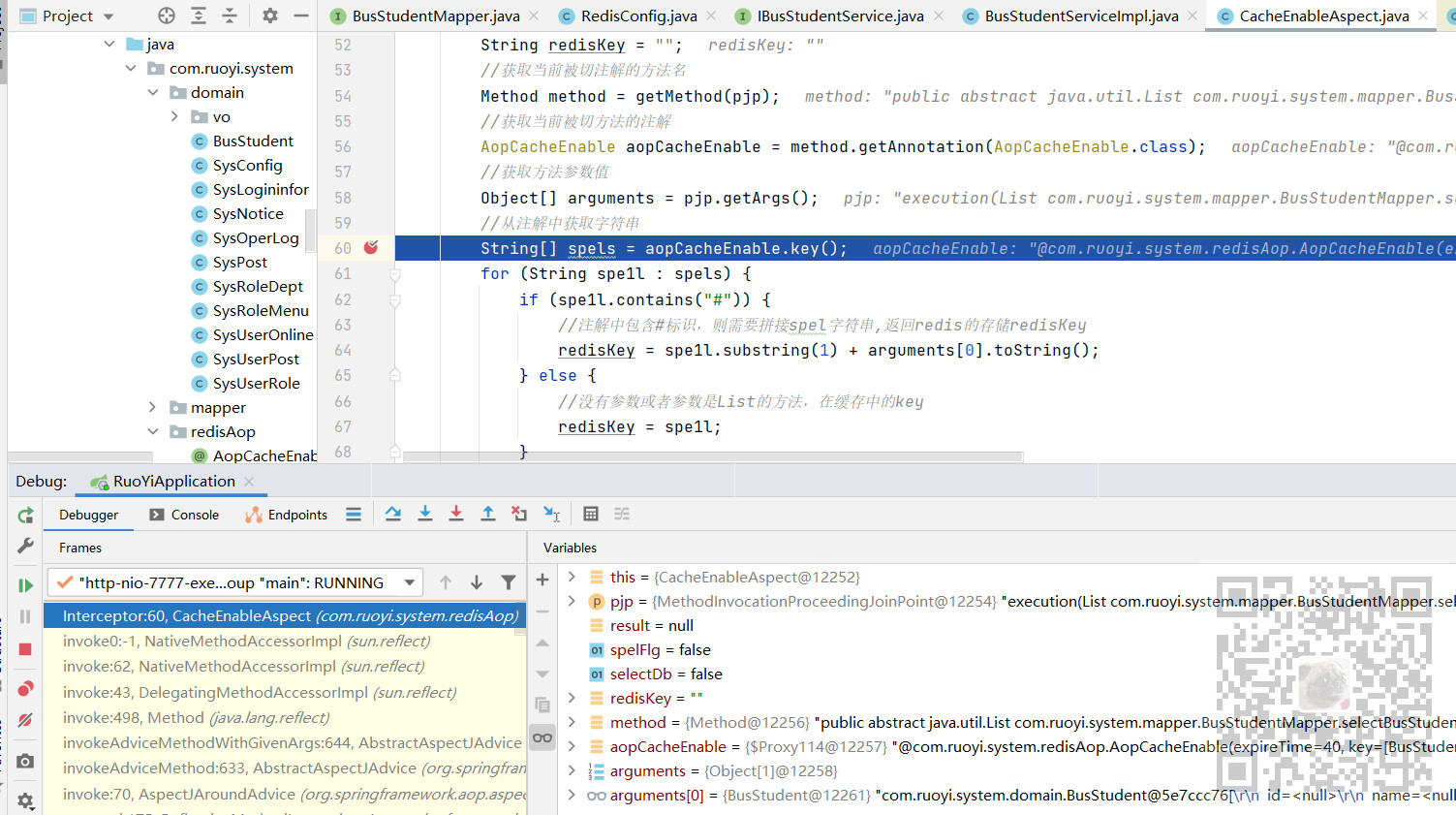

以上就是SpringBoot中怎么通过自定义缓存注解实现数据库数据缓存到Redis的详细内容,更多请关注php中文网其它相关文章!

每个人都需要一台速度更快、更稳定的 PC。随着时间的推移,垃圾文件、旧注册表数据和不必要的后台进程会占用资源并降低性能。幸运的是,许多工具可以让 Windows 保持平稳运行。

Copyright 2014-2025 https://www.php.cn/ All Rights Reserved | php.cn | 湘ICP备2023035733号